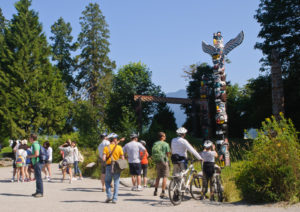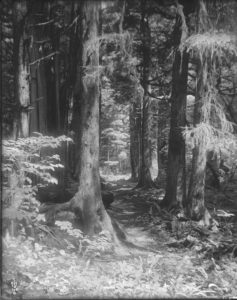On October 29, 1889,Charles Stanley, the Governor General of British Columbia, formally christened a new park in Vancouver, dedicating it “to the use and enjoyment of peoples of all colours, creeds, and customs, for all time. I name thee, Stanley Park.” Little did he know that the use and reputation of the park would grow to the extent that Stanley Park was named the world’s best park in 2014 by the users of TripAdvisor!
The park actually opened one year earlier, in September, 1888 (but Stanley himself was ill and could not attend what we would today call the “soft opening”). At the time, Vancouver had just over 6,000 residents—choosing to set aside a park of this size was a dramatic undertaking for this frontier town. Today the park is the equivalent of New York’s Central Park or Nairobi’s Uhuru Park. At nearly 900 acres in area, Stanley Park is the third largest urban park in the world. Annually, it has more than 8 million recreation visits.

Stanley Park has the typical rich history of use for a western land area. It was home to three First Nations groups—the Squamish, Burrard Band and Musqueam peoples—who used the land for centuries as hunting and gathering grounds. During the 1800s, the area was increasingly occupied by European settlers who logged the dense forest for lumber and established small farms. Vancouver was incorporated as a city in 1888, and the first action taken by the new far-sighted City Council was to begin the steps to create a park.
The park itself is a peninsula that juts northward from downtown Vancouver, separating Vancouver Harbor from the Strait of Georgia. More than half of the park area remains in forest, dominated by western red cedar, Douglas fir and bigleaf maple. Although the area was extensively logged during the late 19th Century, many “monument trees” remain, some centuries old. The forests have also been subject to severe blow-downs by fierce wind storms, the most recent in 2006. The city planted 15,000 trees after the 2006 wind storm to restore damaged areas.

Along with forested areas and their associated hiking and biking trails, the park contains numerous areas developed for outdoor recreation. Original and modern totem poles and other First Nations’ artwork grace the property. Three beaches attract thousands daily during the summer months. Forest trails cover nearly 17 miles. A seawall winds around the park, providing accessible walking and biking paths; combined with other paths adjoining the park, the 13.7-mile trail is the longest uninterrupted waterfront path in the world. A botanical garden and aquarium are located in the park, but a historic zoo was closed recently when the last remaining animal, a polar bear named Tuk, died in 1994. The presence of the park helps earn Vancouver’s reputation as one of the greenest cities in the world.
References:
City of Vancouver. Stanley Park. Available at: https://vancouver.ca/parks-recreation-culture/stanley-park.aspx. Accessed October 24, 2018.
Kheraj, Sean. Historical Overview of Stanley Park. Stanley Park Ecology Society. Available at: http://stanleyparkecology.ca/wp-content/uploads/downloads/2012/02/SOPEI-Historical-Overview-of-Stanley-Park.pdf. Accessed October 24, 2018.
Today in Canadian History. 1889 – October 29. Available at: http://canadachannel.ca/todayincanadianhistory/index.php/October_29. Accessed October 24, 2018.
